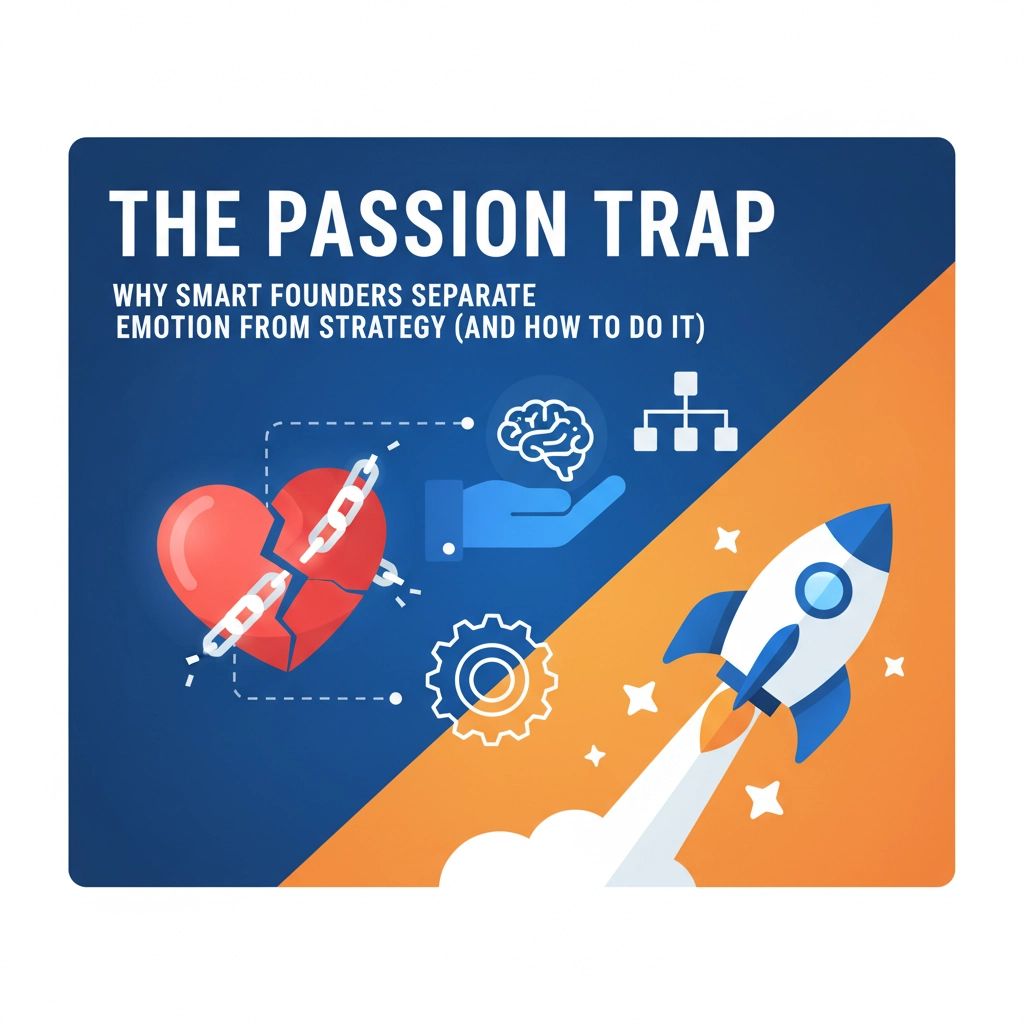The Passion Trap: Why Smart Founders Separate Emotion from Strategy (And How to Do It)
Oct 08, 2025
You've spent years perfecting your deeptech/healthtech breakthrough. The science is solid. The potential is massive. But here's the brutal truth: 92% of technical founders who let passion drive strategy never reach Series A.
The passion trap isn't just a business school concept: it's the silent killer of brilliant deeptech/healthtech startups. And if you're reading this, there's a good chance you're already caught in it.
What Is the Passion Trap? (And Why Technical Founders Fall Hard)
The passion trap is a self-reinforcing loop where your emotional investment in your technology becomes the primary driver of business decisions. You love your innovation so much that market feedback, financial realities, and strategic pivots feel like betrayals of your vision.
Here's how it typically unfolds:
- You believe deeply in your technology's world-changing potential
- Market feedback contradicts your assumptions
- Instead of pivoting, you double down on "educating" the market
- You burn through runway while competitors with "inferior" tech gain traction
- Investors pass because you can't demonstrate clear market fit

This isn't about lacking passion: passion fuels the persistence you need to solve hard problems. The trap emerges when passion overrides data-driven strategy.
John Bradberry's research shows this pattern destroys more startups than lack of funding, poor products, or market timing combined. For technical founders, the stakes are even higher because your innovations require significant capital and longer development cycles.
💥 The Three Warning Signs You're In the Trap
1. You're "Educating" Rather Than Listening
When prospects don't immediately grasp your technology's value, your instinct is to explain harder rather than questioning your positioning. Smart founders flip this: they treat confusion as market intelligence, not ignorance.
2. You're Optimizing Technology Before Proving Demand
You keep adding features, improving performance metrics, or pursuing patents while customer discovery takes a backseat. The brutal reality: technical excellence doesn't guarantee commercial success.
3. You Dismiss "Lesser" Competitors Who Are Gaining Traction
You rationalize their success as temporary or based on inferior solutions. Meanwhile, they're capturing market share with simpler, more accessible alternatives.
If any of these sound familiar, congratulations: you're not broken. You're just operating from the wrong playbook for commercial success.
🔥 The Strategic Separation Framework
Step 1: Implement the 90/10 Rule
90% of your strategic decisions should be data-driven. 10% can be passion-driven bets.
This means:
- Customer feedback outweighs your technical preferences
- Market timing trumps product perfection
- Revenue metrics guide resource allocation more than R&D excitement

Step 2: Create Your Reality Check Board
Assemble 3-5 advisors who will tell you uncomfortable truths:
- One experienced deeptech/healthtech investor
- One successful founder from your space
- One potential enterprise customer
- One industry expert with no financial stake in your success
Meet monthly. Ask hard questions. Listen more than you defend.
Step 3: Establish Emotion-Free Decision Triggers
Define specific metrics that trigger strategic changes, regardless of how you feel about them:
- If customer acquisition cost exceeds lifetime value by 3x for 6 months → pivot messaging
- If 10 qualified prospects can't articulate your value prop → simplify positioning
- If runway drops below 18 months without Series A traction → consider strategic alternatives
These aren't suggestions: they're emergency protocols that activate automatically when emotions might cloud judgment.
📊 The Numbers-First Strategy System
Track These 5 Metrics Weekly:
- Customer Discovery Conversations: 10+ per week minimum
- Value Prop Validation Rate: % of prospects who can repeat your value back accurately
- Sales Cycle Length: Time from first contact to signed LOI
- Technical Milestone vs. Commercial Milestone Ratio: Should be 1:2 or better
- Investor Meeting to Follow-up Rate: Measures story clarity and market fit

Why these metrics matter: They force objective evaluation of commercial progress, not just technical achievements.
The Monthly Strategic Health Check
Answer these questions honestly every 30 days:
- Are we solving a problem customers will pay to solve?
- Is our go-to-market strategy generating predictable results?
- Would I invest in this company if I weren't the founder?
If you can't answer "yes" to all three, your passion might be overriding strategic clarity.
⚡ Turning Passion Into Your Competitive Advantage
Smart founders don't eliminate passion: they channel it strategically.
Use Passion For:
- Persistence through technical challenges that would stop competitors
- Recruiting exceptional talent who believe in your vision
- Maintaining momentum during inevitable startup valleys
- Inspiring investors with authentic conviction about market opportunity
Use Data For:
- Market positioning and messaging decisions
- Feature prioritization and product roadmap
- Fundraising timing and valuation expectations
- Hiring priorities and resource allocation
The most successful technical founders we work with describe this as "passionate execution of data-driven strategy."

🚀 Your Next Steps (Do This Week)
Immediate Actions:
Day 1: Audit your last 10 strategic decisions. Were they passion-driven or data-driven?
Day 2: Schedule customer discovery calls with 5 prospects who didn't convert
Day 3: Set up your reality check board: send outreach messages today
Day 4: Define your emotion-free decision triggers using the framework above
Day 5: Implement weekly metrics tracking system
This isn't about becoming emotionally detached: it's about becoming strategically disciplined while maintaining the passion that makes hard problems worth solving.
The Bottom Line: Data-Driven Passion Wins
The founders who successfully navigate from post-seed to Series A aren't the ones who love their technology most. They're the ones who love their customers' success most and use their technology passion as fuel for relentless execution of market-validated strategy.
Your breakthrough deserves to reach the market. But only strategic discipline will get it there.
Ready to transform your passion into a funding magnet? The most successful technial founders don't just build better technology: they build better decision-making systems that turn brilliant innovations into scalable businesses.
Your technology might change the world. Your strategy will determine whether it gets the chance.
Want to dive deeper into strategic frameworks that actually work for technical founders? Check out our other insights on building exit-driven strategy that makes investors want to write bigger checks.
